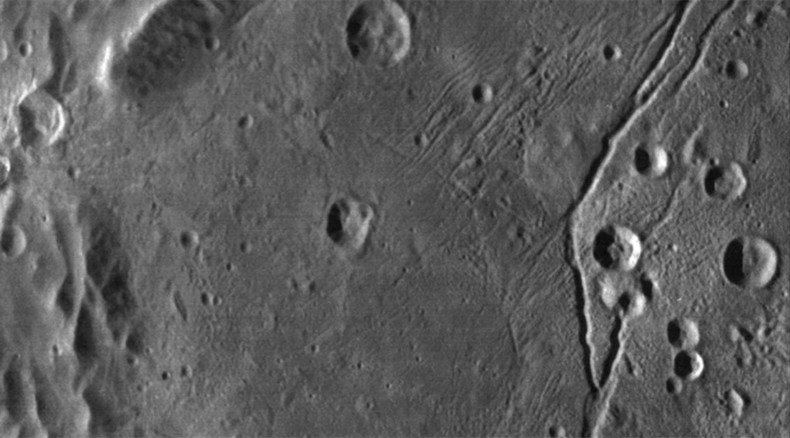Much like Earth’s Moon’: NASA releases high-res pics of Pluto’s satellite Charon (PHOTO)

NASA has released the first highest-resolution images of Pluto’s largest moon, Charon, revealing grooves and impact craters, which are similar to the surface of our planet’s Moon.
The photos were taken by the Long Range Reconnaissance Imager (LORRI) aboard the New Horizons interplanetary space probe on July 12. Taken shortly before the spacecraft’s closest approach to Pluto, the images resolve details as small as 310 meters.
The first picture, released by the US space agency, was a mosaic, in which “the view moves from rugged cratered terrain, across the great faulted canyons of the Serenity Chasma, and onto the resurfaced plains of Vulcan Planum, both informally named.”

The second photo showed the close up on Vulcan Planum, with “its rilles (grooves or long, narrow depressions) and intermittently spaced impact craters, highlights a landscape reminiscent of the volcanic plains on Earth’s moon (lunar mare),” NASA’s website said.
However, the agency pointed out that the plains on Charon are made of water ice unlike the ones on Earth’s Moon, which consist of basalt.

Earlier this week, the scientists behind the New Horizons program published its first scientific results in Science magazine, saying that the “Pluto system is remarkable."
Their findings debunked past theories that suggested the dwarf planet was just a plain, cratered surface.
The New Horizons’ photos revealed smooth plains, a blue hazy atmosphere, icy mountains and complex landscapes both on Pluto and Charon.
READ MORE: NASA reveals first official findings of Pluto mission
"How can these small, cold objects be so diverse? What's driving what seems to be tectonic activity on the surface, these glacier flows, these incredibly complicated regions on the surface that just look like a jumbled mess of giant, icy mountains? The variety of the surface features has been a big surprise," Hal Weaver, New Horizons project scientist, told The Washington Post.
Pluto is a dwarf planet situated in the ring of bodies beyond Neptune known as the Kuiper belt.
READ MORE: What flying over Pluto's moon Charon would look like (VIDEO)
After its discovery in 1930, it was considered the ninth planet in the Solar system, but its status was changed in 2005 after the discovery of a larger object nearby.
Meanwhile, the New Horizons probe, which is now 5 billion kilometers away from the Earth, is set to continue its mission moving even deeper into the Kuiper belt.












